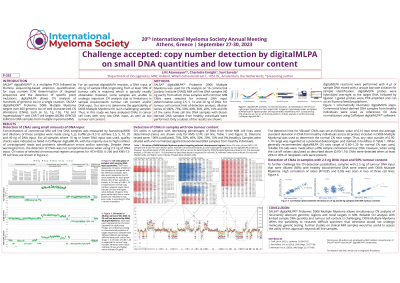Myeloma Genomics and cell signaling
Poster Session 3
P-332: Challenge accepted: copy number detection by digitalMLPA on small DNA quantities and low tumour content
Friday, September 29, 2023
1:15 PM - 2:15 PM EEST


Lilit Atanesyan, PhD
Lead Specialist Onco- and Epigenetics
MRC Holland
Amsterdam, Noord-Holland, Netherlands
Introduction: A novel next-generation sequencing-based MLPA variant – digitalMLPA, allows copy number (CN) analysis of hundreds of genomic loci in a single reaction. SALSA digitalMLPA Probemix D006 Multiple Myeloma)targets 469 genomic loci allowing reliable copy number detection of well characterized CN alterations (CNAs) (1p, 1q, 13q, 17p and hyperdiploidy) as well as of CAR-T cell targets (BCMA, GPRC5D, FcRH5) in DNA samples from multiple myeloma (MM). For an optimal digitalMLPA reaction, 40 ng of sample DNA originating from at least 50% of tumour cells is required, which is typically readily obtainable. However the remaining samples are unable to undergo important CN analysis due to limitations in sample requirements. Our aim is to determine the applicability of SALSA digitalMLPA Probemix D006 Multiple Myeloma for challenging samples, and thus, in this study we have analysed CNAs in cancer cell lines with very low DNA input, as well as low tumour cell content.
Methods: SALSA digitalMLPA Probemix D006 Multiple Myeloma was used for CN analysis on 16 commercial MM cell line DNA samples. For minimal sample DNA input determination digitalMLPA reactions were performed with 2.5, 5, 10 and 20 ng gDNA from three cell lines. For tumour cell content detection limit analysis, dilution series of 10%, 20%, 30%, 40%, 50% and 75% of the same cell line DNA samples with blood-derived DNA samples from healthy individuals were performed. digitalMLPA reactions were performed with 4 µl sample DNA mixed with a unique barcode solution for sample identification. digitalMLPA probes were hybridized overnight to the target DNA, followed by ligation. Ligated probes were PCR amplified and run on an Illumina NextSeq platform. Commercial blood-derived DNA samples from healthy individuals were used as references for data normalization using Coffalyser digitalMLPA™ software.
Results: CN losses at 1p21.1-p22.1, 1p12, 13q and GPRC5D, and CN gains at 1q21.1-q23.3 and FCRL5 in NCI-H929 cell line were reliably detected even when 2.5 ng input DNA was used. Similarly, all expected CNAs were correctly identified when using 2.5 ng input DNA in other cell lines too. CNAs in tumour-healthy DNA dilutions series were reliably detected if the abnormality was present in at least 20-30% of the analysed sample given that reference samples show highly reproducible probe ratios. In addition, in all analysed samples with 50% neoplastic cell content and 40 ng input DNA CNAs detected on all target loci were highly correlated with those reported in public databases.
Conclusions: SALSA digitalMLPA Probemix D006 Multiple Myeloma is well suited for multiplex CNA detection of routinely analysed genomic regions in MM, allowing analysis of samples with limited DNA and tumour cell content. In addition, due to the selection of targeted loci, one reaction of this assay serves multiple purposes – detection of well characterized CNAs in MM, other genomic regions and CAR-T therapy targets.
Methods: SALSA digitalMLPA Probemix D006 Multiple Myeloma was used for CN analysis on 16 commercial MM cell line DNA samples. For minimal sample DNA input determination digitalMLPA reactions were performed with 2.5, 5, 10 and 20 ng gDNA from three cell lines. For tumour cell content detection limit analysis, dilution series of 10%, 20%, 30%, 40%, 50% and 75% of the same cell line DNA samples with blood-derived DNA samples from healthy individuals were performed. digitalMLPA reactions were performed with 4 µl sample DNA mixed with a unique barcode solution for sample identification. digitalMLPA probes were hybridized overnight to the target DNA, followed by ligation. Ligated probes were PCR amplified and run on an Illumina NextSeq platform. Commercial blood-derived DNA samples from healthy individuals were used as references for data normalization using Coffalyser digitalMLPA™ software.
Results: CN losses at 1p21.1-p22.1, 1p12, 13q and GPRC5D, and CN gains at 1q21.1-q23.3 and FCRL5 in NCI-H929 cell line were reliably detected even when 2.5 ng input DNA was used. Similarly, all expected CNAs were correctly identified when using 2.5 ng input DNA in other cell lines too. CNAs in tumour-healthy DNA dilutions series were reliably detected if the abnormality was present in at least 20-30% of the analysed sample given that reference samples show highly reproducible probe ratios. In addition, in all analysed samples with 50% neoplastic cell content and 40 ng input DNA CNAs detected on all target loci were highly correlated with those reported in public databases.
Conclusions: SALSA digitalMLPA Probemix D006 Multiple Myeloma is well suited for multiplex CNA detection of routinely analysed genomic regions in MM, allowing analysis of samples with limited DNA and tumour cell content. In addition, due to the selection of targeted loci, one reaction of this assay serves multiple purposes – detection of well characterized CNAs in MM, other genomic regions and CAR-T therapy targets.
